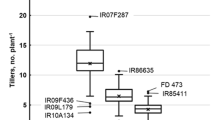Abstract
An effecient, reproducible and simple mass screening technique for the selection of salt tolerant rice lines has been developed. Fourteen-day old seedlings raised in silica gravel culture were transplanted to foam-plugged holes in polystyrene (thermopal) sheets floated over 100 dm3 of nutrient solution in painted galvanised-iron growth tanks lined with plastic (120×90×30cm). Three days after transplanting, NaCl was added to salinize the medium in increments, at the rate of 25 mol m-3 per 24 hours, up to the desired salinity levels which ranged from 50–200 mol m-3 NaCl. Six plants of each line were transplanted and allowed to grow for 15 days after the maximum desired stress level was achieved in each case. Absolute shoot fresh and dry weights, as well as percent mortality, were used as criteria for assessing relative salt tolerance. Related studies were also conducted to standardize the technique. The validity of this technique was tested by conducting experiments in salinised soil (pot culture) and in salt-affected field where 9 rice lines were grown up to maturity and absolute paddy yield was considered as the criterion for salt tolerance. Salt tolerance behaviour of cultivars based on different selection criteria was compared. Good reproducibility of results among the three solution culture experiments and their close association with the results of pot culture and of salt-affected field study, authenticated the validity of this technique for practical purposes.
Similar content being viewed by others
References
Abrol I P 1984 Salinity problems in rice productionIn application of Remote Sensing for Rice Production. Eds. Adarsh Deepak and K R Rao. pp 89–105. A Deepak Publishing, India.
Akbar M 1986 Breeding for salinity tolerance in rice.In Salt-affected soils of Pakistan, India, and Thailand. pp 39–63. The International Rice Research Institute, Los Baños, Philippines.
Akbar M and Ponnamperuma F N 1982 Saline soils of South and Southeast Asia as potential rice lands.In Rice Research Strategies for the Future. pp 265–281. The International Rice Research Institute, Los Baños, Philippines.
Aslam M, Qureshi R H, Ahmed N and Muhammed S 1988 Response of rice to salinity shocks at various growth stages and type of salinity in the rooting medium. Pak. J. Agri Sci. 25, 199–205.
Aslam M, Qureshi R H, Ahmed N and Muhammed S 1989 Salinity tolerance in rice (Oryza sativa L.). Morphological studies. Pak. J. Agric. Sci. 26, 92–98.
Aslam M, Qureshi R H, Ahmed N and S Nawaz 1990 Effect of different external K+/Na+ and Ca2+/Na+ ratios on growth, ionic composition and selectivity of rice lines varying in salt tolerance. Pak. J. Agric. Sci. 27, 436–445.
Cabuslay G S and Akita S 1986 Physiology of varietal response to salinity. I. Effect of nutrient concentration and pH on salt tolerance. Japan J. Crop Sci. 55, Extra Issue 1, 26–27.
Duncan D B 1955 Multiple range and multiple F-tests. Biometrics 11, 1–42.
Farah M A and Anter I M 1978 Salt tolerance of eight varieties of rice. Agric. Res. Rev. 56, 9–15.
Ikehashi H and Ponnamperuma F N 1978 Varietal tolerance of rice for adverse soils.In Soils and Rice. 825. The International Rice Research Institute, Los Baños, Philippines.
IRRI 1979 Annual Report for 1977. The International Rice Research Institute, Los Baños, Philippines.
Iwaki S 1956 Studies on the salt injury in rice plant. Memoirs of the Ehime Univ. (Agriculture) 2, 1–156.
Jones M P and Stenhouse J W 1983 Salt tolerance of mangrove swamp rice varieties. IRRI Newsletter 8, 8–9.
Maas E V and G J Hoffman 1977 Crop salt tolerance-current assessment. J. Irrig. Drain Div. 103, 115–134.
Panaullah G M 1980 Effect of five salt concentration on the chemical kinetics of a submerged soil and the growth and yield of four rice varieties. M. Sc. Thesis, University of Philippines at Los Baños, Los Baños, Philippines.
Pearson G A 1961 Role of cultivar tolerance in increasing rice production in saline lands.In Salinity Tolerance in Plants-Strategies for Crop Improvement. Eds. R C Stables and G H Toenniessen. pp 255–271. Wiley International, New York.
Qureshi R H, Aslam M, Mustafa G and Akhtar J 1991 Some aspects of physiology of salt tolerance in wheat (Triticum aestivum L.). Pak. J. Agric. Sci. 28, 199–206.
Rengel Z 1992 The role of calcium in salt toxicity: Review. Plant Cell Environ. 15, 625–632.
Richards R A 1983 Should selection for yield in saline regions be made on saline or non-saline soils? Euphytica 32, 431–438.
Singh M, Chhabra R and Abrol I P 1979 Annual Report, Central Soil Salinity Research Institute, Karnal, India.
Verma K S and I P Abrol 1980 A comparitive study of the effect of gypsum and pyrites on soil properties and the yield of rice and wheat grown in highly sodic soil.In International Symposium-Salt-affected Soils. Eds. IRRI. pp 330–338. Karnal, India.
Yano S, Ogawa M and Yamada Y 1982 Plant formation from selected rice cells resistant to salt.In Plant Tissue Culture. Ed. A Fujiwara. 839 p. Japan Assoc. P1. Tissue Culture.
Yeo A R and Flowers T J 1984 Mechanisms of salinity resistance in rice and their role as physiological criteria in plant breeding.In Salinity Tolerance in Plants-Strategies for Crop Improvement. Eds. R C Stables and G H Toenniessen. pp 151–170. Wiley International, New York.
Yeo A R, Yeo M E, Flowers S A and Flowers T J 1990 Screening of rice (Oryza sativa L.) genotypes for physiological characters contributing to salinity resistance, and their relationship to overall performance. Theor. Appl. Genet. 79, 377–384.
Yoshida S 1981 Fundamentals of rice crop science. The International Rice Reserves Institute, Los Baños, Philippines. 269p.
Yoshida S, Forno A D, Cock J H and Gomez K A 1972 Laboratory Manual for Physiological Studies of Rice. The International Rice Research Institute, Los Baños, Philippines. 66p.
Author information
Authors and Affiliations
Rights and permissions
About this article
Cite this article
Aslam, M., Qureshi, R.H. & Ahmed, N. A rapid screening technique for salt tolerance in rice (Oryza sativa L.). Plant Soil 150, 99–107 (1993). https://doi.org/10.1007/BF00779180
Received:
Accepted:
Issue Date:
DOI: https://doi.org/10.1007/BF00779180




